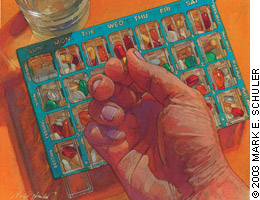
Am Fam Physician. 2003;68(4):589

Lately we've been doing a lot of housekeeping at the publishing offices of AFP. Although the editorial and production staffs spend most of their time creating the pages of AFP, sometimes duty calls, and we have to stop for other things. I'm not talking about the breaks we take to prevent venous stasis (that is, trips to the coffee pot or trips to the “T & I Center,” where we keep “T,” or “Treats,” like chocolates and deep-fried, sugar-glazed fat rings, and “I,” or “Information,” like sign-up sheets for potlucks). I'm talking about stopping for distractions like having to move an entire archive of AFP journals because our storage space was suddenly reallocated. We've just finished moving one of our complete AFP collections from one floor to another for permanent storage.
Those of you who have been reading AFP over the years might have a feel for the way issues stack up. If you're like me, you might have a collection stored at home. If you've ever moved a collection of AFP volume by volume—one volume being six months' worth, or six to 12 issues depending on what year you pick—you'll know how heavy they are. These are stout books constructed with heavy paper stock, and over the years AFP has been more thick than thin. A 50-year collection of the journal represents over 670 separate issues and weighs most of a ton.
Of course, the editorial and production staffs didn't actually move all the journals up the stairs by themselves. Professional movers did most of the lifting. The production staff worked to unpack the boxes and sort the issues onto extra shelves that were squeezed into their storage area. The editors just kind of poked around at the boxes of leftover journals and did what editors do—stay out of the way as much as possible while salvaging bits of treasure from the trash pile.
That's pretty much what I was doing when the production manager came to me and asked, “So, has it hatched yet or not?” “What?” I looked down at the box I was keeping warm. “The August 15 Inside AFP.” “Oh, that.” That's when it hit me. Back in the old days, AFP was published 12 times a year, and the managing publisher wrote 12 “Pub Memos” a year. That went on for 40 years. Then in the space of a decade, AFP went from 12 to 16, to 20, then to 24 issues per year. At some point the publisher stopped writing the publisher's page and gave it to the managing editor. Now the managing editor writes “Inside AFP,” one for each of 24 issues. What was once done over the span of two years is now done in one. That includes writing an “Inside AFP” for the August 15 issue—which happens to fall on my birthday. “So,” I thought, “It's my party and I'll cry if I want to.” With that thought and a kind of morbid curiosity, I decided to look for an issue published the month I was born to see what it was like, and here's what I found:
A rather old book with the name “GP” on its teal and white cover, with a crooked spine and two major crinkles crossing 356 yellow, faintly mildewed pages. Hugh Hussey, M.D., was the editor. Cost was $1 a copy. Oh dear.
A lead article called “Psychiatric Aspects of Aging.” No kidding! I read it with interest. According to the article, a survey by the American Psychiatric Association shows the highest emotional concerns of Americans today are “health and economic security, love and supporting relationships, more adequate and sure feeling as parents, release from the anxiety that comes from danger of war, rising prices, vocational and professional security, a large cluster of needs revolving around the family between the husband and wife, parent and child and other familial relationships.” Whew. Guess I'm not as dated as I thought.